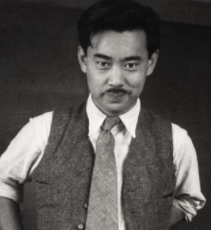Japanese-American woodworker, furniture maker, architect and designer George Katsutoshi Nakashima was one of the leading innovators of 20th century furniture design, and father of the American artisan movement.
Image source:https://filmfreeway.com/GeorgeNakashimaWoodworker
Who was George Katsutoshi Nakashima?
George Katsutoshi Nakashima was born in 1905 in Washington, to Katsuharu and Suzu Nakashima. In 1929, he obtained a Bachelor of Architecture from the University of Washington and two years later, he earned a Master’s degree in architecture from MIT. Immediately after, Nakashima sold his car and bought a ticket for the world’s steamboat. In 1937, he created his first furniture set after veing commissioned to build a dormitory in an ashram, in India. Three years later, Nakashima decided to return to the USA, where he continued to make furniture and teach woodworking before, during World War II, being sent to Idaho, where he met Gentaro Hikogawa, from whom Nakashima learned the carpentry techniques and the use of Japanese instruments.
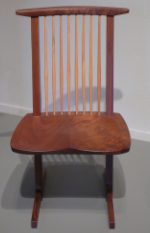
Image source:https://search.creativecommons.org/photos/7192e3e5-e087-4567-92e4-5c5e3ac1fad6 by jimcchou
Over the past decade, his furniture has become ultra-collectible and his legacy has cemented into what has become known as an influential “free-edge” aesthetic. Nakashima’s work achieves a warmth, grace and purity that make it so universally appealing and appropriate, and with the same flourish of movement of a Picasso, becoming regarded as the maker of an aesthetic bridge between East and West. George died in 1990, but the workshop is still going strong today under the direction of his daughter, Mira, who recounts her dad’s life and work, often with colorful photos of the furniture.
What were his most noteworthy works?
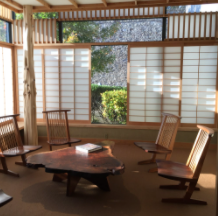
Image source:https://search.creativecommons.org/photos/90d2cac6-506e-4017-9498-1d64f7eb30cc by lblanchard
Among his projects,the Conoid chair is perhaps the most iconic of all the models created by Nakashima. The term “conoid” refers to the cone-shaped roof structures designed by George for his architectural work. Those produced in the Nakashima workshop, today, are slightly different from the first version that George built in 1971. The design of the product is accurate in every detail and reveals the search for minimalist elegance through careful study; the structure is characterized by the presence of two legs that extend from the feet in the form of a sled, which serve as uprights that support a cantilevered seat and a ridge bar with cantilevered ends. Usually, these main parts are made of black walnut, while the spindles are made of hickory, shaved and faceted by hand with a blocking plane.
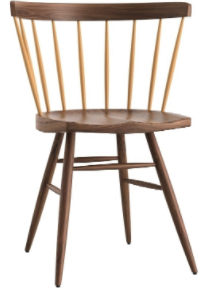
Image source: https://www.miliashop.com/it/sedie/8384-straight-sedia-knoll.html
On the other hand, the Straight Chair is George Nakashima’s modern interpretation of the traditional Windsor chair. The Japanese-American woodworker was able to challenge the typical categorization, by mixing oriental and western aesthetics, traditional and modern vocabularies. At the beginning of 1940s, Hans and Florence Knoll met Nakashima and they remained very surprised and impressed by the simple elegance of his aesthetic. Therefore, they decided to add a chair and three tables of George’s design to the Knoll catalog. The first orders were made in Nakashima’s studio, before production was transferred to East Greenville and the line was discontinued in 1955 when Nakashima opted to produce and market all of its projects. With its simplistic form and materials, the Straight chair does not strive to be something that is not. It is characterized by low-gloss finishes that amplify the grain motifs and it shows Nakashima’s deference to the natural beauty of wood and its legendary craftsmanship.
What are the main characteristics of Nakashima’s style?
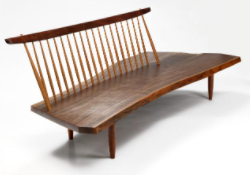
Image source:https://americanart.si.edu/artwork/conoid-bench-32461
Today, the name Nakashima is synonymous with huge tables with natural edges; structure with visible dovetails; a lot of solid wood; and wooden keys. George Nakashima is one of the most recognized and famous artisans of the twentieth century, known above all for his handmade furniture and for the sensitivity to the material’s needs. During his life, he explored the organic expressiveness of wood. Inspired by Japanese culture and modern American style, he created a series of works that best represent the 20th century American art furniture. His design was distinguished by its woodworking and was mainly made up of large tables consisting of several slabs of wood connected with butterfly joint. These plates were characterized by smooth surfaces but natural and unfinished edges. Perhaps his greatest contribution to art is his originality. He specialized in beautiful tables, lovingly crafted from large pieces of wood in their natural state and following the wood grain, whenever possible. His benches, chairs and lamps are also highly coveted by collectors and decorators. Nakashima shares the list of most sought out furniture designers with Carlo Mollino, Jean Prouvé and Marc Newson, according to the experts.
Furniture should be lived with and not treated as something overly precious.
George Nakashima

Image source: https://americanart.si.edu/artwork/minguren-ii-coffee-table-79359
Info sources:
http://content.lib.washington.edu/exhibits/dream-design-build/nakashima.html
https://www.woodcraft.com/blog_entries/famous-furniture-the-conoid-chair
https://grshop.com/george-nakashima-straight-chair.html
https://www.azureazure.com/homes/the-wonderful-woodwork-of-george-nakashima02
